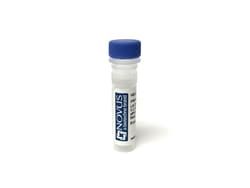AMPD3 Antibody (AMPD3/901) - IHC-Prediluted, Novus Biologicals™
Manufacturer: Novus Biologicals
Select a Size
| Pack Size | SKU | Availability | Price |
|---|---|---|---|
| Each of 1 | NBP248158-Each-of-1 | In Stock | ₹ 45,078.50 |
NBP248158 - Each of 1
In Stock
Quantity
1
Base Price: ₹ 45,078.50
GST (18%): ₹ 8,114.13
Total Price: ₹ 53,192.63
Antigen
AMPD3
Classification
Monoclonal
Conjugate
Unconjugated
Formulation
10mM PBS and 0.05% BSA with 0.05% Sodium Azide
Gene Symbols
AMPD3
Immunogen
Recombinant full-length human AMPD3 protein (Uniprot: Q01432)
Quantity
7 mL
Primary or Secondary
Primary
Test Specificity
It recognizes a protein of ∼90kDa, which is identified as Adenosine Monophosphate Deaminase, isoform E (AMPD3). It has 767 amino acids and is assigned an EC 3.5.4.6. It is a highly regulated enzyme that catalyzes the hydrolytic deamination of adenosine monophosphate to inosine monophosphate, a branch point in the adenylate catabolic pathway. AMPD3 gene encodes the erythrocyte (E) isoforms, whereas other family members encode isoforms that predominate in muscle (M) and liver (L) cells. This monoclonal antibody shows reactivity with cells of the erythroid lineage at all stages of maturation in the peripheral blood, bone marrow, and fetal liver. Non-erythroid lineages are negative by flow cytometry. This monoclonal antibody is useful in the diagnosis of erythroleukemia, identification of bone marrow erythroid precursors, gating erythroid nucleated precursor cells from malignant cells in bone marrow specimens.
Content And Storage
Store at 4C.
Isotype
IgG2b κ
Applications
Immunohistochemistry (Paraffin)
Clone
AMPD3/901
Dilution
Immunohistochemistry-Paraffin
Gene Alias
adenosine monophosphate deaminase (isoform E), adenosine monophosphate deaminase 3, AMP aminohydrolase, AMP deaminase 3, AMP deaminase isoform E, EC 3.5.4.6, Erythrocyte AMP deaminase, erythrocyte type AMP deaminase, erythrocyte-specific AMP deaminase, myoadenylate deaminase
Host Species
Mouse
Purification Method
Protein A or G purified
Regulatory Status
RUO
Gene ID (Entrez)
272
Target Species
Human
Form
Purified
Related Products
Description
- AMPD3 Monoclonal specifically detects AMPD3 in Human samples
- It is validated for Immunohistochemistry, Immunohistochemistry-Paraffin.
